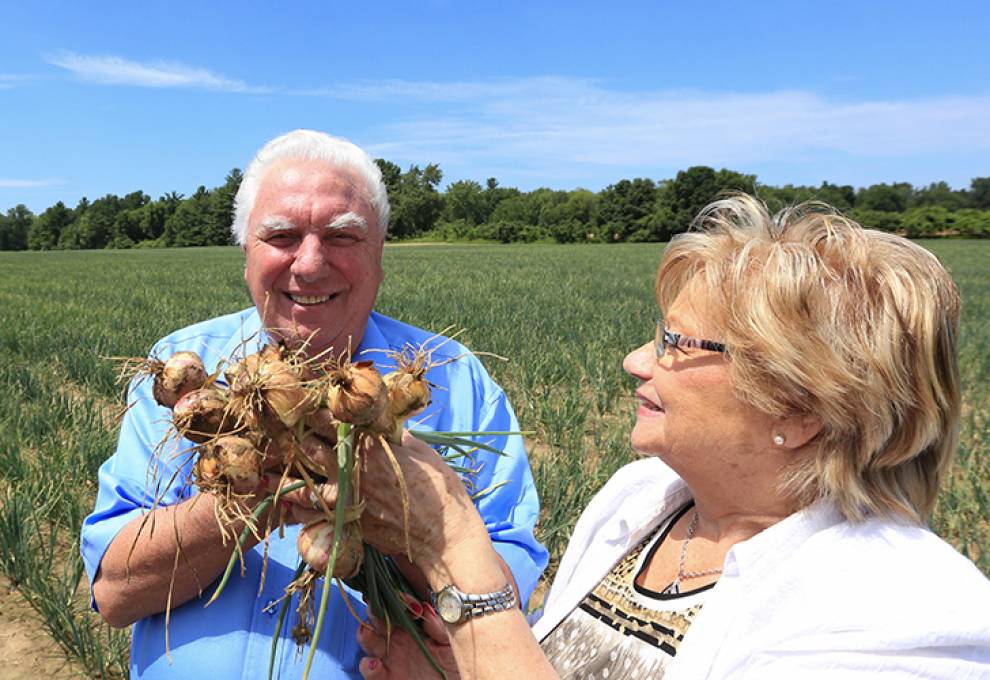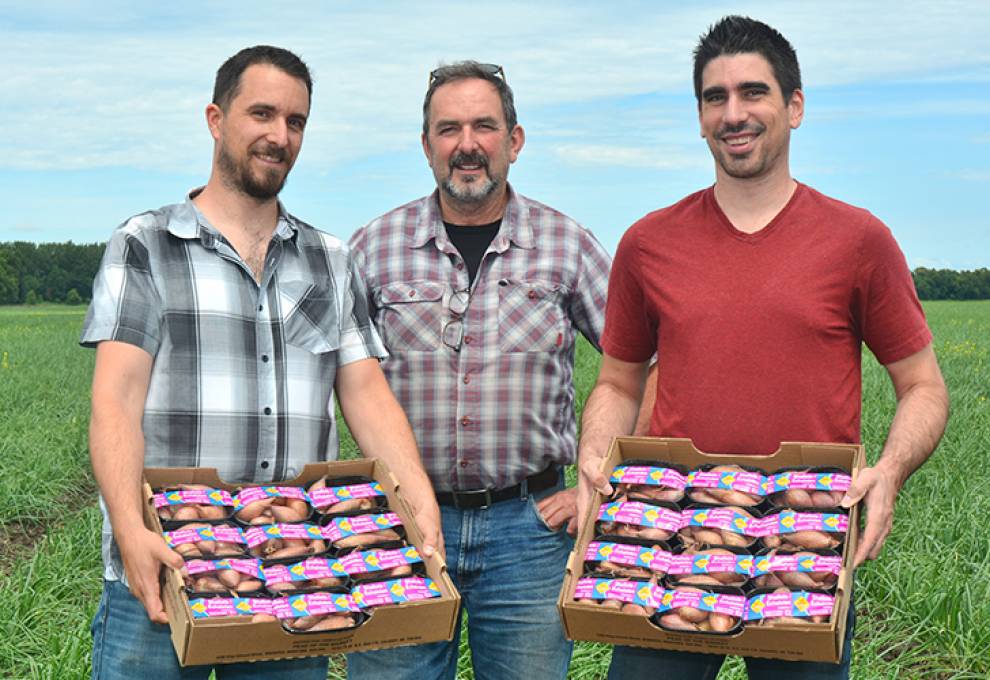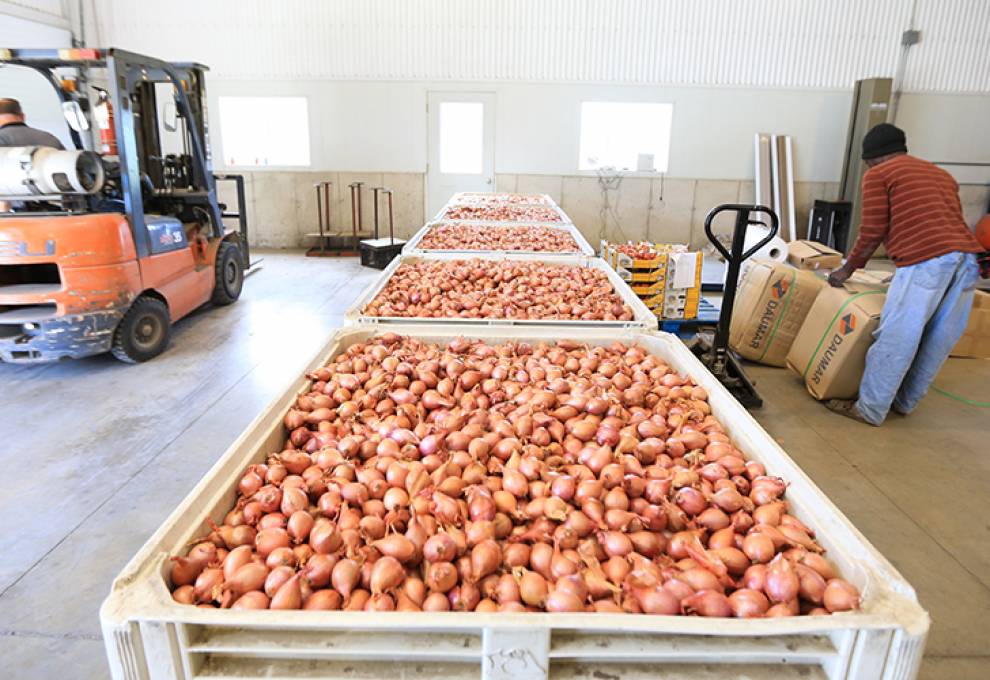


Shove over, onions. Make room for shallots.
That’s the rallying plea of a handful of Canadian growers who specialize in the aromatic. Frank Schroyens and his family have been digging a niche for the European delicacy since 1998. When they immigrated from Belgium to Straffordville, Ontario, they were astonished to discover that shallots were an unknown entity.
The Belgians saw an opportunity whereas local farmers saw only more work. Three small shallots equal one small onion. “Shallots are totally different from an onion,” says Schroyens. “You can’t compare.” While he may be describing the gastronomic characteristics of the copper-skinned cloves, Schroyens is also alluding to the agronomic differences. Seed is sourced from France and Holland. Specialized equipment, imported from Europe, is required for seeding, harvesting, packing and storing. Shallots require 2°C at 75 per cent humidity in storage.
The biggest hurdle was convincing retailers to buy shallots. Botanically, they belong to the Allium family which includes onions, garlic, scallion, leeks and chives. As a smaller cousin to the onion, shallots are also less pungent and therefore prized for their use raw in salads and dressings. Besides attractive pink-coloured flesh, shallots score high in sucrose sugars, a trait that allows them to caramelize readily in the sauté pan.
It’s this story of their cooking virtues that persuaded Costco’s produce buyer Oleen Smethurst to visit the Schroyens farm many years ago. Today, the packing facility is food-safety audited annually to meet the standards of Costco as well as other retailers. At Costco stores, you can find three-pound shallot packages.
The biggest hurdle is to build the retail market. It takes time to build awareness.
~ LOURENS ARENDSE
Other retailers such as Metro and Sobeys prefer the 350-gram package while Loblaw purchases 250 grams.
There’s plenty of risk in specializing in shallots, but also profit and pride in being one of the few suppliers of this crop. The cost of growing onions is one-quarter of what it costs to grow shallots.However, the premiums for shallots are 40 per cent higher than onions if the crop can be harvested and stored properly.
Manitoba grower Lourens Arendse shares a similar trajectory to success. Originally a potato and onion grower near Portage La Prairie, he and his sons Sandor and Tim have transitioned out of that crop and since 2003, specialized in onion sets and shallots. Their company, L.A. Quality Products Ltd., now grows 100 acres of onion sets and 150 acres of shallots.
“The biggest hurdle is to build the retail market,” says Arendse. “It takes time to build awareness.”
After all these years, the Europeans consume 250 grams of shallots per capita compared to North American consumption of only 50 grams per capita. That fact can be discouraging or as Arendse says, an incentive to grow the market.
As suppliers to Peak of the Market cooperative in Winnipeg, they have developed a punnet tray so that the shallot skins leave no mess in the store. One-third of their production is sold domestically where they see room to grow the retail market. The rest of their crop is sold to the U.S.
As Arendse explains, there are several perils in growing a niche crop. Increasingly, erratic weather -- such as flooding in 2011 – can wipe out the crop which has higher input costs. If Europe grows a big crop, then product flows into North America and depresses prices. It’s up to growers themselves to promote and build consumer awareness.
These dangers are offset with defensive strategies. Plantings of shallots are spread over a multitude of fields to spread the weather risk. Crop insurance can mitigate any weather damage. Because the Arendse family grows shallots at a latitude north of the 49th parallel, the product is more authentic and true to the European standard for shallots. The quality of “northern” shallots is a distinguishing feature, one that outshines the shallots grown in the southern U.S. where they are more prone to splits and molds.
For these two growers, significant infrastructure has been built to handle the specialty crop. However market gardeners can also prosper with small acreages of shallots. Jan van der Heide, a Bejo Seeds representative for the northeastern U.S., notes that shallot seed sales have increased by 10 to 15 per cent, year over year, in the last decade. He attributes growth to the ingredient-driven agenda of TV cooking shows, which in turn sparks interest among consumers.
“Shallots do well at farmers’ markets,” says van der Heide, who represents varieties such as Conservor, Ambition and Picador. The standby variety has been Conservor which echoes the traditional, tear-drop-shaped French shallots. However, Ambition is a newer brown-skinned variety that is round-shaped and stores well, important attributes for those wanting to market year-round. More recently, Picador has been introduced, a more vigorous plant with higher yields. All mature within 90 days.
These varieties are well suited for those wanting to experiment. One seed produces one shallot. His best tip? Borrow an onion seeder to plant shallot seed.
Van der Heide estimates that Canadian shallots are grown on no more than 600 acres. Those copper gems add up to more than cents. Statistics Canada reports that in 2015, the shallot and green onion category had a farmgate value of $29.2 million.

Add new comment